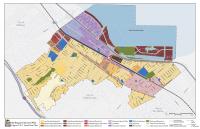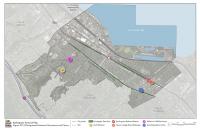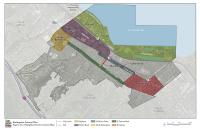Sustainable Development
Climate scientists have identified clear relationships between land use patterns, development types, and greenhouse gas emissions. The creation of walkable and bike-friendly neighborhoods with higher-density, mixed use, infill development around transit stations can reduce vehicle trips and associated pollutant emissions. Use of energy-efficient building materials, green construction practices, and the reduction of impervious surfaces can also contribute locally to reductions in greenhouse gas emissions, and improvement in water quality. The City of Burlingame is committed to reducing its carbon footprint by promoting sustainable development through a variety of means.
Burlingame’s Climate Action Plan (CAP), last updated in 2019, sets the framework for City policies relating to greenhouse gas reduction. Given the ties between land use policy practices and climate change affects, the City has incorporated CAP considerations and policies into this General Plan; see the Healthy People Healthy Places Element. The sustainable development policies move Burlingame forward in reducing the community’s carbon footprint, protecting local environmental resources, and creating healthy people and healthy places.
As discussed in the Community Safety Element, Burlingame’s Bayfront location exposes properties and the populace to the adverse effects of sea level rise and flooding. Strategies to combat climate change and prepare for the impacts of sea level rise through resilience are integrated throughout this General Plan. The following goal and policies reflect the City’s approach to promoting sustainable practices in future development and protecting existing development from elevated sea levels and flooding. Additional policies relating to sustainability are incorporated throughout the other elements, and in the Healthy People Healthy Places Element in particular.
Goal: CC-1
Incorporate sustainable practices in all development decisions.
Require that all major development projects include a Transportation Demand Management (TDM) program, as defined in the City’s TDM regulations, to reduce single-occupancy car trips. “Major development” shall be defined in the TDM regulations by square footage for commercial development, or minimum number of units for residential development.
Promote water conservation by encouraging and incentivizing property owners to incorporate drought-tolerant landscaping, “smart” irrigation systems, water-efficient appliances, and recycled water systems. Continue to enforce the water-efficiency landscaping ordinance. Encourage recycling and reuse of graywater in new buildings.
Encourage green infrastructure systems that rely on natural processes for stormwater drainage, groundwater recharge, and flood management, continue to implement storm drainage fee programs that discourage broad applications of impervious surface coverage, and require that new development minimize impervious surfaces and meet San Mateo Countywide Stormwater Pollution C.3 requirements.
Support the use of sustainable building elements such as green roofs, cisterns, and permeable pavement, continue to enforce the California Green Building Standards Code (CALGreen), periodically revisit the minimum standards required for permit approval, and adopt zero-net-energy building goals for municipal buildings.
Establish programs that encourage and enable owners of new and existing single family homes to provide onsite drainage systems to retain runoff on site and allow for percolation into the groundwater table. For new multifamily residential development projects, require such systems to comply with San Mateo Countywide Stormwater Pollution Prevention Section C.3


